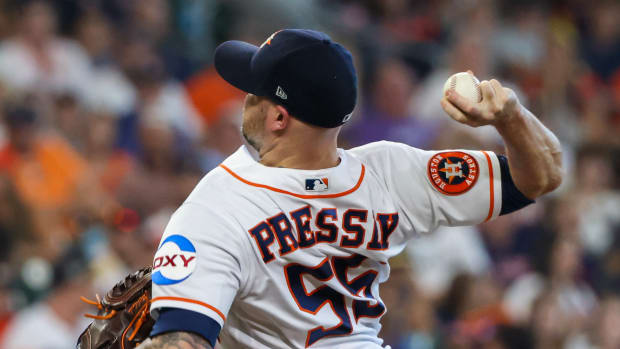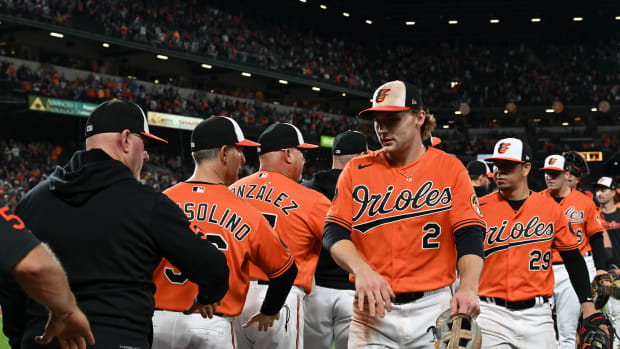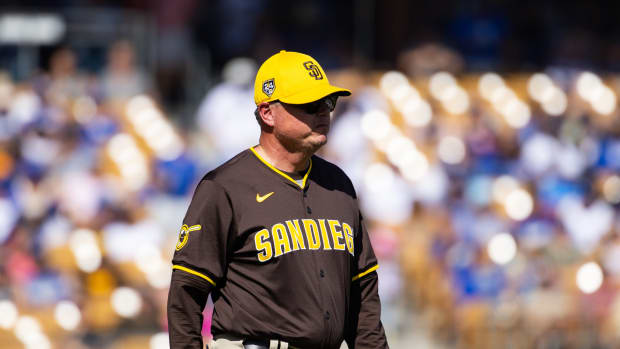Grading the Deal: The Mets Make a Familiar, Boring Signing in Jay Bruce
After weeks of inaction, the hot stove was finally sparked back to life by, of all teams, the Mets. On Wednesday night, New York reportedly came to terms with free-agent outfielder Jay Bruce on a three-year, $39 million deal—beating out the Giants and Astros, among others—that reunites the club with the veteran it traded away last summer. Back in Queens for the second time in 18 months, Bruce should make an impact for a team that slumped to 92 losses last season, but it has to be disappointing to Mets fans that New York’s first major move of the winter is to bring back a player with limited upside—and perhaps at the expense of other spots on the roster that still need some serious help.
Bruce, who will be 31 in April, is coming off a season split between the Mets and the Indians, whom he joined via a waiver trade in early August. Straddling the AL and the NL, he posted a 115 OPS+ and hit 36 home runs in 2017, a new career high (although one that loses some impact given that virtually every player set a personal best in that mark last year thanks to the juiced ball). Power from the left side is Bruce’s game—he’s bopped fewer than 25 home runs in a season just once in the last seven years—but it’s just about the only thing keeping his offense afloat. His 2017 on-base percentage of .324 was in the bottom 20 of all qualified outfielders, and yet that still represented his best showing in that stat in four seasons. His 22.5% strikeout rate, meanwhile, was also among the league’s worst.
Further crimping Bruce’s value is his defense, which ranges from mediocre to ghastly in rightfield (and at first base, which he played briefly for both the Mets and Indians last year). Add that to his low-OBP ways, and Bruce’s overall numbers take a hit: His 2.9 WAR last year was a fine number, but it’s hardly a star performance. And last year was the first time since 2013 that he’s gotten that figure anywhere above even 1.0; from ’14 through ’16, he was worth a grand total of 0.3 WAR.
What Is Jake Arrieta Really Worth?
Given his defense, age and free-swinging ways, Bruce may not seem like the kind of player at whom you throw a multi-year contract. But the Mets do have a need for him. Reduced to playing scrap-heap pickup Nori Aoki and uninspiring minor leaguer Travis Taijeron in right after dealing Bruce away, New York could use help in the outfield, especially with Michael Conforto set to miss the start of the season after suffering a severe shoulder injury in late August. Bruce could also help pick up the slack at first base if prospect Dom Smith continues to struggle with his adjustment to the majors. His power, meanwhile, gives new manager Mickey Callaway (who got to know Bruce from their shared time in Cleveland) an easy option to slot behind Yoenis Cespedes in the lineup, making the Mets that much deeper offensively. Plus, the price was relatively right, at just $13 million a year and for only three seasons. And for whatever it’s worth, the Mets apparently highly value Bruce’s veteran leadership and clubhouse presence for a team that got dramatically younger last season.
In that sense, Bruce is worth the money and commitment, especially given that the Mets aren’t likely to make many—if any—more splashes on the market. Those dollars are better spent than squirreled away in the bank accounts of Fred and Jeff Wilpon, no matter how you value Bruce. But while he’s a perfectly fine fit, he’s also somewhat of a frustrating addition. This is a team that collapsed to 92 losses thanks to roughly a thousand injuries and has problems up and down the roster. As it currently stands, New York would be trotting out Asdrubal Cabrera at third base and Wilmer Flores at second on Opening Day—far from ideal in either case. On top of that, the starting pitching depth is woefully thin. Matt Harvey, Steven Matz and Zack Wheeler are some of the least durable pitchers in baseball (and, in the case of Harvey and Wheeler, the least effective), yet all three will be trusted with rotation spots right from the get go with only Seth Lugo and disappointing prospect Rafael Montero as their backups. Those spots need to be addressed, but the Mets have instead turned to a player in Bruce who can’t plug any of those holes and who doesn’t make the team dramatically better.
Even in the outfield, while Bruce fills a need, the Mets may have been better served by focusing on finding a new centerfielder instead. Someone like Lorenzo Cain—a top-flight defender, good hitter and perfect leadoff option for a team without one—would have made a lot of sense. Cain comes with his own drawbacks, namely his age (32 in April) and the draft pick he would have cost the Mets thanks to the qualifying offer the Royals extended him, but he would have been worth the investment. And if the Mets didn’t feel comfortable meeting Cain’s asking price, a combination of Jarrod Dyson or Carlos Gomez and Todd Frazier (for example) could have roughly equaled Bruce’s production and covered two positions of need.
What Is Lorenzo Cain Really Worth? More Than You May Think
Instead, the Mets went with the devil they know, spending what potentially little free-agent capital they have on a good-yet-limited hitter and poor defender. And while there’s nothing to suggest that the Mets are necessarily done spending money, this is a team that’s seemingly allergic to taking risks in the offseason; over the last two years, New York’s biggest signings have been Cespedes and Bruce, who were known quantities in the eyes of the front office. (For further proof of the Mets’ miserly ways, see this report that a trade for Indians second baseman Jason Kipnis was close to being done but was ultimately scuttled for financial reasons.)
Given the state of the roster and a fan base desperate to see the team spend in a way fitting its market, the Mets arguably should have aimed higher and gone for more upside. They chose to play it safe, and though spending money on Bruce is better than not spending at all, the Mets still need to do more if they want to return to the ranks of the contenders.
Grade: B-


































